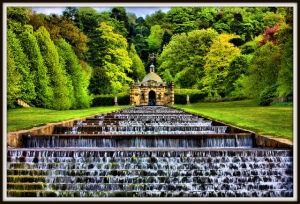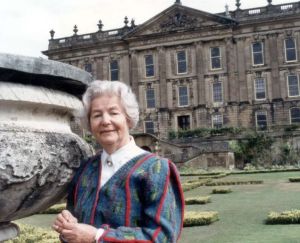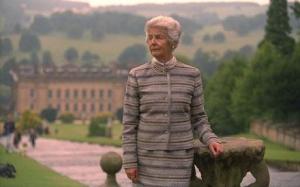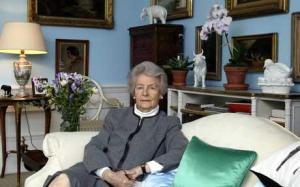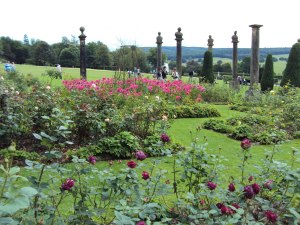Deborah Vivien Cavendish, Duchess of Devonshire DCVO (née Deborah Freeman-Mitford; 31 March 1920 – 24 September 2014), was the youngest and last surviving of the six Mitford sisters who were prominent members of English society in the 1930s and 1940s.
Life
Known to her family as “Debo”, Deborah Mitford was born in Asthall Manor, Oxfordshire, England. She married Lord Andrew Cavendish, younger son of the 10th Duke of Devonshire, in 1941. When Cavendish’s older brother, William, Marquess of Hartington, was killed in combat in 1944, Cavendish became heir to the dukedom and Marquess of Hartington; in 1950, upon the death of his father, he became the 11th Duke of Devonshire.
The Duchess was the main public face of Chatsworth for many decades. The Duchess wrote several books about Chatsworth, and played a key role in the restoration of the house, the enhancement of the garden and the development of commercial activities such as Chatsworth Farm Shop (which is on a quite different scale from most farm shops as it employs a hundred people); Chatsworth’s other retail and catering operations; and assorted offshoots such as Chatsworth Food, which sells luxury foodstuffs which carry her signature and Chatsworth Design which sells image rights to items and designs from the Chatsworth collections. Recognising the commercial imperatives of running a stately home, she took a very active role and was known to run the ticket office for Chatsworth House herself. She also supervised the development of the Cavendish Hotel at Baslow near Chatsworth and the Devonshire Arms Hotel at Bolton Abbey.
In 1999 the Duchess was appointed a Dame Commander of the Royal Victorian Order (DCVO) by Queen Elizabeth II, for her service to the Royal Collection Trust. Upon the death of her husband in 2004, her son Peregrine Cavendish became the 12th Duke of Devonshire. She became the Dowager Duchess of Devonshire at this time.
She and the duke had seven children, four of whom died shortly after birth:
- Mark Cavendish (born and died 14 November 1941)
- Emma Cavendish (born 26 March 1943, styled Lady Emma Cavendish from 1944), mother of the fashion model Stella Tennant
- Peregrine Cavendish, 12th Duke of Devonshire (born 27 April 1944)
- An unnamed child (miscarried December 1946; he or she was a twin of Victor Cavendish, born in 1947)
- Lord Victor Cavendish (born and died 22 May 1947)
- Lady Mary Cavendish (born and died 5 April 1953)
- Lady Sophia Louise Sydney Cavendish (born 18 March 1957)
She was also a maternal aunt of Max Mosley, former president of the Fédération Internationale de l’Automobile (FIA), as well as the grandmother of Stella Tennant, a fashion model.
Death
Her death, at the age of 94, was announced on 24 September 2014. The Duchess was survived by three of her seven children, eight grandchildren and eighteen great-grandchildren.
Selected interviews
She was interviewed on her experience of sitting for a portrait for painter Lucian Freud in the BBC series Imagine in 2004.
In an interview with John Preston of the Daily Telegraph, published in September 2007, she recounted having tea with Adolf Hitler during a visit to Munich in June 1937, when she was visiting Germany with her mother and her sister Unity, the latter being the only one of the three who spoke German and, therefore the one who carried on the entire conversation with Hitler. Shortly before ending the interview, Preston asked her to choose with whom she would have preferred to have tea: American singer Elvis Presley or Hitler. Looking at the interviewer with astonishment, she answered: “Well, Elvis of course! What an extraordinary question.”
In 2010, the BBC journalist Kirsty Wark interviewed the Duchess for Newsnight. In it, the Duchess talked about life in the 1930s and 1940s, Hitler, the Chatsworth estate, and the marginalisation of the upper classes. She was also interviewed on 23 December by Charlie Rose for PBS. She spoke of her memoir and other interesting aspects of her life. On 10 November 2010, she was interviewed as part of “The Artists, Poets, and Writers Lecture Series” sponsored by the Frick Collection, an interview which focused on her memoir and her published correspondence with Patrick Leigh Fermor.
Titles from birth
- The Honourable Deborah Vivien Freeman-Mitford (1920–1941)
- The Lady Andrew Cavendish (1941–1944)
- Marchioness of Hartington (1944–1950)
- Her Grace The Duchess of Devonshire (1950–2004)
- Her Grace The Dowager Duchess of Devonshire (2004-2014)

